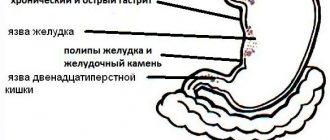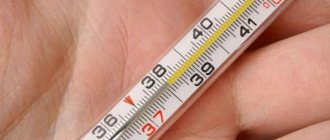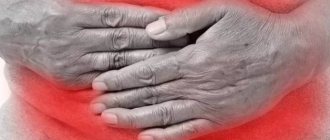Causes of vomiting and diarrhea in a child without fever
Many factors can influence the occurrence of diarrhea and vomiting. Doctors divide the causes into groups: pathological, physiological. The latter appear actively in the period up to 3 years, when the first teeth appear.
In primary school and preschool age, anxiety arises associated with being away from home and homework, which will lead to vomiting and diarrhea. Pathological causes include: intestinal infections, food poisoning, allergies, dysbacteriosis, exacerbation of gastrointestinal diseases, helminthiasis.
Intestinal infection
Vomiting and diarrhea in a child without fever may occur due to rotavirus or unwashed hands disease. Symptoms usually appear 3 days after infection. During an average of 2 days of incubation period, the baby does not show signs of infection.
Intestinal infection is a parasitic disease. It is transmitted 90% through unwashed hands when the baby touches objects affected by the virus. In other cases, infection by airborne droplets is possible. The peak incidence occurs between the ages of 3 and 5 years, when the child attends preschool.
Most often, vomiting and diarrhea in a child are caused by gastrointestinal infections.
If one preschooler carries the infection, the rest of the children will get sick in 90% of cases.
Rotavirus occurs with an increase in temperature if the baby experiences the infection for the first time. With repeated infection, as a rule, immunity is developed and the disease progresses more easily.
The child's symptoms may include:
- diarrhea;
- vomit;
- nausea;
- stomach ache;
- the skin takes on a grayish or pale tint;
- dehydration of the body.
If the infection is severe, convulsions and loss of consciousness may occur. They are associated with prolonged dehydration of the body, when parents cannot independently stop vomiting and diarrhea in the baby.
Diarrhea always accompanies rotavirus, since the infection affects the intestines. Due to pathogenic microflora, stool can increase up to 15 times a day. There are sometimes mucus in the stool, indicating an inflammatory process. Rotavirus always goes away with nausea, which turns into vomiting if not treated in a timely manner.
The symptom occurs due to simultaneous damage not only to the intestines, but also to the entire gastrointestinal tract. Parents often note that diarrhea and vomiting do not alternate, but occur simultaneously. A sick child does not get off the potty or toilet and vomits.
Dehydration occurs when vomiting occurs along with diarrhea. The body loses a lot of fluid. Doctors advise immediately giving the baby special electrolyte solutions or plain water, which allows you to quickly flush out the infection from the body and replenish the fluid balance.
Dehydration is easy to recognize; the child complains of severe weakness. Sometimes children cannot get out of bed on their own, walk to the toilet, or take a few steps. Loss of consciousness may occur due to excessive dehydration and loss of strength.
Food poisoning
Vomiting and diarrhea in a child without fever are characteristic of toxic infection. Low-quality, expired store-bought and home-made products can cause damage to the body.
Causes toxic infection due to dangerous toxins contained in foods, unwashed vegetables and fruits. In 40% of cases, children are poisoned by confectionery, pickled foods, milk, smoked meats, canned food, and exotic foods.
Children are more susceptible to toxicological infections than adults. This is due to the lack of enzymes that bind and remove toxins. The child’s intestinal function is underdeveloped; the microflora of the organ cannot independently cope with harmful substances.
If a low-quality product enters the body, it takes from half an hour to a day before the first signs of illness appear. At the beginning of the disease, the child feels chills, weakness, abdominal pain, and cramps in the intestines. The course of the infection can vary depending on the age of the patient, the type of pathogenic bacteria, and the amount eaten.
Food poisoning is characterized by:
- increased weakness;
- chills;
- vomiting or nausea;
- diarrhea;
- the child refuses to eat;
- severe pain in the abdominal cavity;
- drowsiness;
- spasms in the intestines.
A poisoned child goes through 3 stages of food poisoning: asymptomatic, toxicogenic period and convalescence stage. The second period has severe symptoms; in the third, the body recovers.
Help should be provided within the first hour after symptoms appear.
If the baby vomits more than 2 times, you urgently need to replenish the water and electrolyte balance with liquid, a special drug - Regidron.
Vomiting and diarrhea in a child with food poisoning without fever appear due to a reaction to the invasion of toxic infection.
Thus, the body tries to remove harmful substances. In case of food poisoning, it is important to seek emergency help in time, before the child becomes dehydrated and toxins begin to destroy the functioning of organs.
Dysbacteriosis
During intrauterine development, the baby's intestines are not filled with beneficial bacteria; the organ is sterile. After birth, with the first application to the breast, bifidobacteria and lactobacilli contained in the woman’s colostrum become colonized.
Dysbacteriosis manifests itself as an intestinal disorder that occurs due to an imbalance of microflora, when harmful bacteria predominate over beneficial ones. In newborns, the disease develops due to late breastfeeding, non-compliance with the diet by the young mother, and early introduction of complementary foods.
According to statistics, children who are bottle-fed and mixed-fed are predisposed to dysbacteriosis, with frequent changes of formula.
In children after one year of age, the disease develops as a result of previous intestinal infections, unbalanced nutrition, weakened immunity, and taking antibiotics.
Dysbacteriosis is often caused by helminthic infestations, hormonal disorders, unfavorable psycho-emotional state, and predisposition to an allergic reaction.
Dysbacteriosis manifests itself as symptoms:
- seething, rumbling in the intestines;
- abdominal cramps;
- bloating, increased flatulence;
- diarrhea or constipation;
- nausea or vomiting;
- lack of appetite.
Dysbacteriosis is usually called a disease, which is incorrect from a medical point of view. This is a condition accompanied by a reduced content of beneficial bacteria in the intestinal microflora and an excess of pathogenic ones. Sometimes dysbiosis can be a separate sign of a disease: gastritis, duodenitis, colitis, etc.
Allergic reaction
An allergy occurs when a component enters the digestive tract that is not tolerated by the child. The result is severe abdominal pain, leading to diarrhea and vomiting. Unpleasant symptoms will continue until the entry of the allergic substance into the body stops.
If the product is intolerant, the stool becomes liquid and mixed with mucus. Diarrhea occurs more often than vomiting. The presence of signs depends on the severity of the baby’s condition. Along with diarrhea, severe chills, abdominal pain, nausea and vomiting may occur. If the allergy does not cause inflammation and is treated on time, the child’s body temperature does not rise.
Increasing the level of acetone in the body
Normally, every healthy person has acetone in the body, but laboratory tests should not reveal the component. When this element is detected in a baby’s blood or urine test, they speak of acetonemia. As a rule, the condition indicates diabetes mellitus. More often, a lack of glucose in the blood leads to pathology.
The baby cannot fully produce the necessary enzymes in the blood to process glucose. As a result, the acetone level rises.
An increase in the level of acetone in the urine or blood is accompanied by a number of symptoms:
- arrhythmia;
- rare urination;
- diarrhea;
- increased body temperature (not always);
- excessive sweating, drowsiness;
- skin becomes dry;
- excessive vomiting after eating or drinking water;
- smell of acetone in urine;
- loss of consciousness.
If doctors detect acetone in a child’s urine, the little patient is urgently examined in an inpatient setting. Elevated levels of the component sometimes result in coma.
Inflammation of the gastrointestinal tract
Vomiting and diarrhea in a child without fever often occur during exacerbation of chronic gastrointestinal pathologies. Gastritis, ulcers, duodenitis, pancreatitis, cholelithiasis, biliary dyskinesia, enterocolitis during the inflammatory process have similar symptoms. It is difficult for a non-medical professional to determine what is causing vomiting and diarrhea.
The cause of exacerbation of chronic gastrointestinal diseases is:
- unfavorable environmental conditions;
- non-compliance with diet;
- wrong lifestyle;
- eating too cold or hot foods;
- decline of the immune system;
- frequent colds, stress.
Depending on the pathology, the patient is treated in an inpatient or outpatient setting.
Enteritis
When an inflammatory process occurs in the mucous membrane of the small intestine, we speak of enteritis. The disease occurs due to poor nutrition, somatic pathologies, helminthic infestations, and allergies. Enteritis often occurs as a concomitant disorder during exacerbation of chronic gastrointestinal diseases.
Enteritis can be acute or chronic. In the second form, the baby is bothered by periodic pain in the lower abdomen, heaviness, bloating, flatulence, diarrhea or constipation. When the process is acute, vomiting, diarrhea, rumbling occur, and particles of undigested food are present in the stool.
Metabolic disorders
Substance volume disorders are rare in pediatrics. The condition is not a separate disease; it occurs against the background of disruption of the digestive tract, false hunger, and lack of physical activity.
Studies have shown that the speed of food digestion is influenced by many factors:
- quality of products;
- chewing food (on the run, in large pieces or thoroughly);
- fluid deficiency;
- hypothyroidism;
- lack of vitamins and minerals;
- lack of physical activity;
- overweight;
- high intake of protein foods
You can notice manifestations of slow metabolism by the following signs:
- the child constantly wants to eat;
- overweight;
- acne on the nose, forehead, back;
- diarrhea gives way to constipation;
- nausea when overeating.
Parasites
Helminthic infestations are typical for preschool children. When visiting a kindergarten, where children are constantly exposed to the environment, toys, and other household items, it is easy to become a carrier of a parasitic infection. It is not difficult to notice the presence of pinworms or roundworms in a child’s body if you look closely and observe the baby.
As a rule, infected children have a decrease or, on the contrary, an increase in appetite, weight loss, and a strange rash appears on the body, like an allergic one. The stool alternates with constipation and diarrhea, sleep deteriorates, anal itching occurs, nausea appears, and nails begin to peel. A special analysis called a coprogram will help you find out exactly about the presence of parasites in the body.
Appendicitis
The disease is characterized by an acute inflammatory process of the appendix of the large intestine. The cause of the development of pathology is poor nutrition, parasitic infection, ingestion of feces and indigestible objects into the cecum, congenital anomalies of the organ and its torsion.
Symptoms of appendicitis differ in adults and children. In the latter case, the body’s reaction depends on the stage of the pathology. Uncomplicated appendicitis is asymptomatic in 90%. The baby has minor nagging abdominal pain, nausea, and lack of appetite.
At the destructive stage of the disease, the following occurs:
- pain in the lower abdomen, sometimes radiating to the navel area;
- vomit;
- diarrhea or constipation;
- increased body temperature;
- loss of appetite;
- Shchetkin-Blumberg symptom (sharp pain when pressing with a hand in the projection below the navel, on the right);
- increase in abdominal size;
- flatulence;
- severe spasms.
At the slightest suspicion of appendicitis, parents should call an ambulance. Appendicitis at the stage of acute inflammation (empyema) can lead to perforation of the appendix and death.
One year old child: diarrhea – what to do?
Depending on what caused the digestive upset, diarrhea that appears in one-year-old children and older ones looks different.
- This may be liquid stool, similar to gruel, interspersed with mucus, blood, pus and a strong unpleasant odor.
- Sometimes it acquires a heterogeneous consistency, and pieces of undigested food are visible in it.
- And sometimes the feces become greasy and shiny, difficult to wash off from the child’s skin and from the walls of the potty.
When contacting a specialist, be sure to tell him what the baby’s stool looked like so that the doctor can make the correct diagnosis. After all, for example, if a child is one year old, fever and diarrhea mixed with blood may indicate the presence of damage to the large intestine by dysentery or E. coli - which is very dangerous for the health of the baby.
Causes of vomiting in a child without fever
Children aged 1-2 years should be considered; in infants, vomiting is often associated with a normal reaction of the body associated with reflux of the newborn. To avoid this reaction, you need to hold the baby in a “column” position after feeding, select the right formula, and do not overfeed the baby.
In children under one year old, the following diseases can cause unpleasant symptoms:
- gastroesophageal reflux (if it does not go away after a year, you need to see a doctor);
- pylorospasm (spasm of the pylorus, causing mild periodic vomiting without disturbance of stool);
- pyloric stenosis (profuse vomiting due to a defect in the structure of the muscular layer of the stomach of a congenital nature);
- congenital esophageal diverticulum.
After a year, a child may experience the following pathologies, characterized by vomiting without diarrhea:
- traumatic brain injuries;
- intestinal obstruction;
- gastritis;
- inflammation of the pancreas;
- GSD (cholelithiasis);
- psychogenic vomiting due to nervousness;
- cholecystitis;
- acute gastroduodenitis;
- appendicitis;
- food poisoning.
The listed diseases can be sluggish, latent, and not accompanied by an increase in body temperature.
Once again about how to overcome diarrhea in a baby
Once again I would like to repeat that the manifestations of the disease that a child (1 year old) suffers from - diarrhea, fever, nausea and vomiting - are always a reason to consult a doctor. In this situation, parents of both one-year-old babies and older children should remain calm and prudent.
- Do not try to treat it yourself (especially with antibiotics); you should not stop the diarrhea at any cost.
- Diarrhea is a reaction of the body aimed at getting rid of harmful substances, and the main thing is to prevent the body from losing fluid.
- Stop only particularly thin and watery diarrhea, but only after consulting a doctor.
Be healthy!
Causes of diarrhea in a child without fever
Abnormal bowel movements occur due to physiological or pathological reasons. For psychogenic diarrhea, when a child experiences diarrhea due to a nervous disorder, anxiety, or anxiety, treatment is not required. You can cope with the problem if the cause lies in poor nutrition. If loose stools do not go away after following the diet, you should contact your pediatrician.
Diarrhea without vomiting can be caused by:
- infectious disease;
- enzyme deficiency;
- intestinal dysbiosis, often occurring without vomiting, nausea may occur;
- reaction to medications;
- food allergies.
Diarrhea can also be caused by taking antibiotics.
Modern mothers have long understood that it is not worth giving their child antibiotics without particularly compelling reasons. Since they, while bringing undoubted benefits, can also cause many unpleasant consequences. After all, along with pest microorganisms, they also destroy beneficial bacteria, for example, those involved in the digestion process. This leads to manifestations of dysbacteriosis.
Diarrhea that appears in a child after antibiotics becomes a new test for the body, preventing it from properly recovering from the illness and weakening it more and more.
The fact is that in such cases, many minerals, vitamins and other useful compounds are excreted with feces, which cannot but affect the child’s metabolic state. By the way, dysbiosis develops in response to antibiotics in children much more often than in adults, and this is due to the immaturity of their digestive system.
Causes of vomiting and diarrhea without fever that are safe for a child’s life
There are situations when parents can cope with the situation of vomiting and bowel dysfunction on their own. Typically, such disorders are associated with the body's physiological response to the environment or internal disorders.
Physiological regurgitation
Typically for newborns, does not require special treatment. Occurs in 70% of children under one year of age; it occurs as a result of milk or formula from the stomach back into the esophagus.
The reason for frequent regurgitation is the peculiar shape of the stomach, the short length of the baby's esophagus , and the immaturity of the sphincter, characteristic of newborns. These manifestations disappear with age. You should worry about regurgitation after 1 year, when the problem may be associated with gastroesophageal reflux.
Teething
When teething, minor stool upset may occur and body temperature may rise. The baby will be capricious, put everything in his mouth, and cry in his sleep.
It is easy to recognize teething; you need to touch the baby’s gums with a clean hand. If they are swollen, red or white, or a crack or hole is visible, you can expect a new tooth to appear. As a rule, the first baby teeth appear after 3 months.
There are several ways you can help your baby at home. Pediatricians recommend applying special cooling and analgesic agents (Kalgel, Cholisal) to the problem gums or giving the baby more chews. Nowadays they sell special biting objects that can be cooled and have a calming effect.
Psychogenic vomiting
It can occur at any age, from newborns to older adults. The second name is somatic, as it is associated with a psychological disorder, experiences that affect the functioning of the gastrointestinal tract.
Associated symptoms of psychogenic vomiting include:
- nausea or vomiting;
- spasmodic pain in the abdomen;
- increased sweating;
- lowering blood pressure;
- cardiopalmus.
Younger schoolchildren and preschoolers suffer more from the disease. For the former, the disorder is often associated with passing an exam, unpreparedness for a lesson, or a competition; for the latter, it is with separation from home and separation from parents for a long time.
When to call a doctor. Symptoms of dehydration
Sometimes parents try to help the baby on their own, wasting time trying to save them. If secondary vomiting and diarrhea occur after taking medications, you should call an ambulance.
It is easy to determine dehydration in a baby by symptoms:
- the mucous membranes of the mouth and tongue become dry;
- saliva viscosity increases;
- body temperature rises;
- fever appears;
- excessive exhaustion, the child sometimes cannot move;
- the skin becomes gray.
If vomiting and diarrhea occur in a baby, it is necessary to urgently call an ambulance as soon as symptoms appear. Babies are physiologically unable to drink much, which makes the situation worse. Only doctors can help. The sooner parents seek help, the greater the chance of further outpatient treatment. In other situations, children are taken to the hospital.
First aid rules before the doctor arrives
If a child feels sick, vomits, or has loose stools, you need to act immediately. First aid rules include fluid intake - drinking plenty of fluids. It is advisable to always have Regidron, Pedilight, Oralit in your home medicine cabinet. The drugs allow you not only to replenish water reserves in the body, but also salts and potassium, which are lost during the process of intoxication.
Powders are used in the form of a solution; the correct dose is prescribed in the instructions for the drug. In the first 5 hours, if the baby is dehydrated, give 5-15 ml of solution every 10-15 minutes.
It is important that the child drinks it in small sips. When the condition improves, the dosage is reduced over time (every 20-25 minutes). If the baby cannot drink the solution, you need to use a syringe (without a needle) and inject the medicine through the cheek.
If there are no necessary medications in the house, salt, baking soda, sugar, potassium chloride, and boiled water can save the situation. The components are mixed in the following proportions: for 1 liter of liquid, 4 teaspoons of sugar, 0.5 teaspoons of salt, soda and potassium. Stir the solution thoroughly. You can use it within 24 hours.
Treatment with drugs: groups of drugs, names, instructions
Treatment tactics depend on the pathology leading to vomiting and diarrhea. Treatment is prescribed, as a rule, after relief of intoxication and dehydration of the body. As soon as the little patient feels better, drug therapy begins.
| Disease | Treatment tactics |
| Dysbacteriosis | Antibacterial drugs if bacterial dysbiosis is detected. Medicines are prescribed after testing for sensitivity to antibiotics. Agents that restore microflora (probiotics and prebiotics): Acepol, Bifidumabacterin, Bifiform. Diet (remove sweets, flour, fatty, salty, smoked, foods that cause flatulence from the menu). Drugs are selected depending on the type of pathogen. |
| Gastritis | Enzymatic preparations if necessary (Creon, Panzinorm, Pancreatitis). Medicines to reduce the production of hydrochloric acid (ranitidine, famotidine). Taking antacids (Maalox, Phosphalugel, Almagel). Morbents for diarrhea and vomiting (Activated carbon, Smecta, Enterosgel). Antispasmodics for severe pain (Buscopan, Duspatalin, No-shpa). The gastroenterologist prescribes antibiotics if necessary. A diet that includes foods that do not irritate the gastric mucosa. |
| Gastroesophageal relux | Following a diet (do not overfeed the child, give only healthy food). Drugs that reduce the negative effects of hydrochloric acid on the esophagus (Fanitidine, Ranitidine). Cerucal to stimulate motor activity of the stomach. |
| Food poisoning | Sorbents, drinking plenty of fluids (Regidron), gastric lavage. |
| Allergy | It is treated by taking sorbents for diarrhea and vomiting, plus antihistamines (Zodek, Zyrtec, Suprastin). |
| Intestinal infection | When the temperature rises - Cefekon, Nurofen. Sorbents for removing toxins, Regidron for preventing dehydration and removing harmful components. Antiviral drugs as recommended by a doctor (Viferon suppositories). Dieting. Stool hardening medications should not be given. |
| Parasitic infection | Antihelminthic drugs (Tanaxol, Helmintox, Nemozol). |
First aid for diarrhea and nausea with fever
Emergency elimination of such symptoms does not imply complete treatment. The goal is to alleviate the condition.
Experts recommend carrying out certain activities:
- Gastric lavage. This must be done when there is confidence in poisoning. This procedure is carried out as follows: drink about 6 glasses of water with the addition of potassium permanganate and induce vomiting. Lavage is done until clean water comes out of the stomach. If the procedure is not successful, an ambulance is immediately called.
Use of absorbents. The most famous and popular medicine is activated carbon. Take 1 tablet per 1 kg of body weight. This remedy is used if there is a suspicion of poisoning or infection. Then, be sure to empty your intestines, otherwise toxins will begin to be absorbed into the colon.
- Taking antispasmodics. The use of these drugs is necessary to reduce pain caused by spasms of the liver and intestinal muscles. Medicines used: Duspatalin and No-shpa.
Nutrition: rules, list of products
Vomiting and diarrhea in a child without fever, as a rule, goes away quickly; the baby needs energy replenishment. At first, after the condition has eased, the baby should be given steam omelettes, rice porridge with water, pumpkin, buckwheat or oatmeal.
You can eat boiled eggs in limited quantities - no more than 1-2 per day. Prepare steamed cutlets: fish, lean chicken or beef, rabbit, turkey. Babies can include pumpkin, carrot and zucchini puree in their diet. On the second day, it is possible to consume fermented milk products with a fat content of no more than 2.5%.
What does green stool mean in a child?
But if your baby has not taken antibiotics, and his stool is loose and greenish, what should you do in this situation? What are the causes of diarrhea in a child in this case?
Quite often, this condition does not pose any danger. As mentioned above, in young children the digestive process is not yet fully developed, and this leads to the fact that any change in the usual diet can cause intestinal upset. Its color often depends on the products included in the baby’s menu. So, nettles, lettuces, sorrel, spinach, and broccoli can color your child’s stool, at the same time changing its consistency. And if the baby is calm and cheerful, there is no need to worry.
If a child has green diarrhea accompanied by whims, refusal to eat, and restless sleep, you definitely need to be examined by a doctor. Particularly dangerous is the condition in which blood appears in the stool, and its smell becomes putrid.
Drink
If you become dehydrated in the first hours, you should take Regidron or its analogues. If your health improves, you can give your baby rice water, a weak infusion of St. John's wort in the absence of an allergic reaction, or a weak rosehip drink. How do you know that treatment is helping?
It is easy to understand that therapy has a positive effect on the child if you carefully monitor his condition. The child's vomiting and diarrhea stop, his appetite appears, and on the second or third day his stool becomes normal. The skin changes from gray to pink, a healthy shade, weakness disappears, the temperature normalizes, the baby begins to play, lead an active lifestyle, and take walks.
Article design: Mila Friedan










